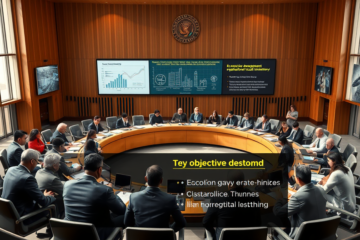Imminent Reduction of the Selic Rate and Favorable Inflation
The Selic Rate, currently at 15%, is in the spotlight due to its direct impact on the Brazilian economy and public debt.
In this article, we will explore the favorable scenario that could lead to a reduction in this rate, highlighting the Central Bank's decision, the effects on credit and consumption, as well as expectations regarding the next bimonthly report and the situation of the Post Office.
We will also discuss the challenges to restoring investment grade status and optimism regarding the future of interest rates in Brazil.
Current Selic Rate Scenario in 15%
The Selic rate, currently at 15%, plays a crucial role in the Brazilian economic scenario, affecting both public debt and household consumption.
However, recent signs indicate that a change in this level could occur soon.
The slowdown in the United States economy combined with the controlled inflation and the devaluation of the dollar creates an environment conducive to cuts.
According to the Central Bank, 'there is room for gradual cuts', creating a positive expectation in the financial market for an earlier-than-expected easing.
In particular, lowering interest rates would provide relief to public finances and greater access to credit for businesses and consumers, thus stimulating the economy.
The impact of keeping the Selic rate at 15% is severe for several sectors, since the increase in credit costs limits investment and consumption.
However, with a more favorable global scenario and a domestic environment of controlled inflation, the market anticipates possible cuts at the next Monetary Policy Committee meeting.
Furthermore, the Central Bank's decision highlights its commitment to economic stability and the convergence of inflation towards the target.
The expectation of cuts is also already reflected in the future interest rate curve, directly impacting the price of fixed and variable income assets, and paving the way for an eventual resumption of economic growth.
Effects of Selic on Public Debt
The Selic rate has a significant impact on the cost of Brazilian public debt.
High Selic increases debt service costs, forcing the government to allocate more resources to interest payments, which limits important investments in essential social areas.
Furthermore, when the Selic rate is high, public accounts are at greater risk, delaying the fiscal adjustment necessary for economic stability.
- Financing cost: each additional percentage point in the Selic rate increases, on average, the annual expenditure on public debt.
- Tax risk: high interest rates make it difficult to adjust public accounts and increase fiscal risk.
To illustrate the impact of different Selic rates on debt expenditure:
| Selic | Interest Expense (R$1,040 billion) |
|---|---|
| 15% | 680 |
| 12% | 540 |
The expectation of a reduction in the Selic rate in the coming months brings relief and could promote economic reactivation, in addition to improving the management of public accounts, according to an analysis by CNN Economy.
This means a more robust recovery is expected in strategic sectors with the potential to boost the economy.
Central Bank Bimonthly Report: Stability in Sight
The Central Bank is about to release its bimonthly report, which promises not to bring significant changes to inflation or economic growth projections.
This document is a true reflection of the current economic environment, highlighting that the price trajectory remains under control.
This stability is essential for maintaining the economic policies already announced.
The report will reinforce that the scenario remains favorable, allowing for an eventual cut in Selic rate, currently at 15%.
This flexibility is a necessary measure to boost credit, boost consumption and boost economic activity.
Focus on stability – Within this context, the Central Bank signals that the possibility of reducing the Selic rate is conditional on the continuation of positive economic indicators.
This reinforces the monetary authority's commitment to boosting economic growth while keeping inflation under control.
Consistent economic policies will be crucial to resuming sustainable growth, especially in an unstable international environment, where the devaluation of the dollar and the slowdown in the US economy pave the way for strategic domestic adjustments.
Financial Situation of the Post Office without Planned Contribution
The Post Office is facing a worrying financial impasse due to lack of resources additional for this year, which puts pressure on the organization to review its investment capacity in crucial areas such as logistics, technology and infrastructure.
This scenario occurs at a time when administrative and financial expenses have skyrocketed spending more than R$ 13.4 billion recently, raising the risk of a significant deficit.
With the committed modernization, the state-owned company finds itself at a competitive disadvantage in a market that demands efficiency.
This deficit is reflected in operations, increasing the chances of delays and compromising the quality of service to consumers.
A lack of adequate funds ends up stifling the Post Office's capacity for innovation, reinforcing the need for urgent structural reforms that can bring financial sustainability and prevent future collapses.
These extreme challenges require agile and effective responses to ensure the company's viability in the coming years.
Investment Grade Outlook and Future Interest Rates
Brazil's recovery of its investment grade is a tangible goal with the right path ahead.
Amidst a challenging global economic scenario, the country is betting on benign inflation and renewed confidence to follow an optimistic path until 2027. The imminent reduction in the Selic rate, currently at 15%, opens the door to a more dynamic economic environment, favoring investment and growth.
- Fiscal discipline: Responsible management of public accounts improves the country's debt profile and is well regarded by rating agencies as a critical step towards positive surprises.
- Sustainable growth: With falling interest rates encouraging productive investment, Brazil is heading towards a robust cycle of economic growth.
- Post-election political stability: After overcoming electoral uncertainty, the political environment stabilizes, reducing risk aversion and creating favorable conditions for economic progress.
- Structural reforms: By implementing vital changes, the country establishes a favorable economic environment, essential for attracting foreign investment and domestic capital.
Thus, as [experts predict](https://www.infomoney.com.br/economia/ceron-critica-penalizacao-de-agencias-de-rating-e-ve-grau-de-investimento-em-2027/amp/ “See details about investment grade”), the reduction in the Selic rate unlocks capital, which can accelerate GDP and enable the recovery of the investment grade, aligning with expectations of positive surprises until the end of the decade.
In short, the expectation is that the Selic Rate will be reduced soon, driven by a favorable economic scenario and inflation control.
The future of the Brazilian economy depends on strategic decisions that can promote sustainable growth.



0 Comments